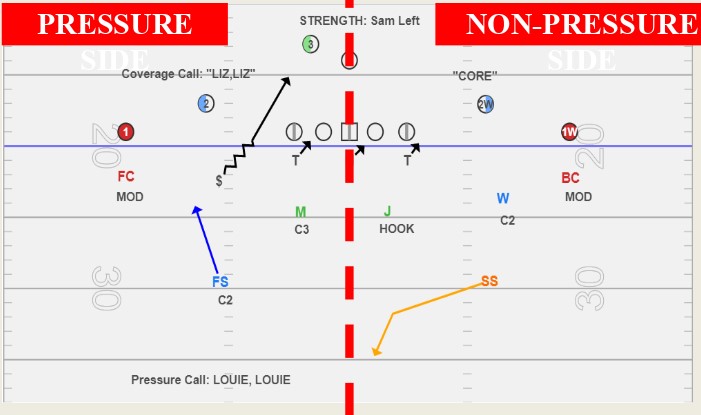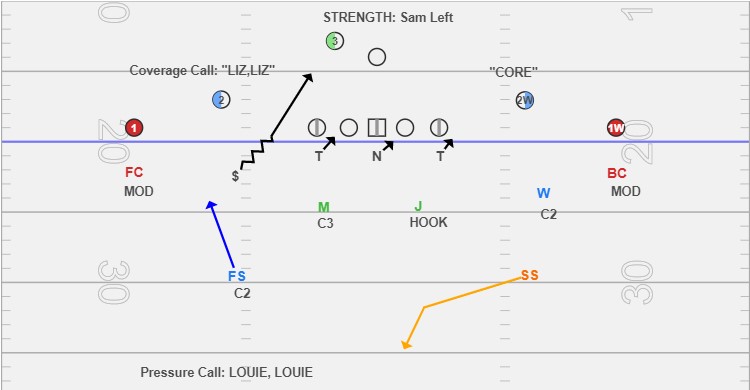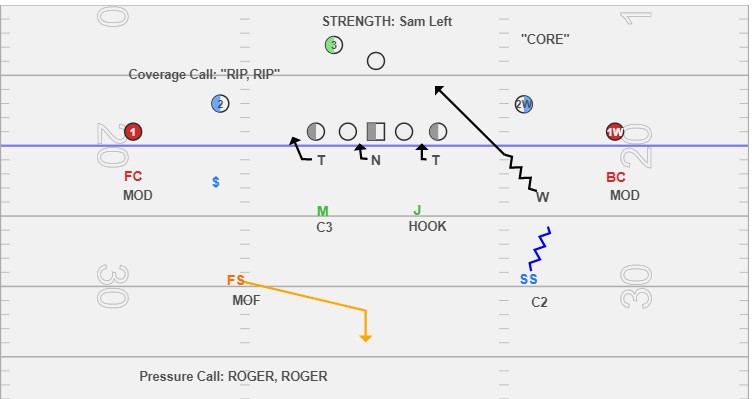By Steve Erxleben
Defensive Coordinator
South River High School (MD)
Twitter: @CoachErxleben
In today's modern challenge of defending offenses that feature multiple formations made up of multiple personnel groupings with multiple forms of tempo, Defensive schemes have to be sophisticated enough to challenge the run, pass, and protection schemes while also be simple enough to allow players to play fast. As a defensive staff here at South River High School, we decided years ago to transition from more of a base front and coverage team to a scheme rooted in zone pressure and match-carry-deliver principles on the backend. Within our culture defensively and as a staff, we believe with the personnel we have and the style of offenses within our league, hanging our hat on zone pressure allows our scheme to be balanced, have the specific force and alley rules, has a reduced amount of checks, is highly adjustable, and allows us to prevent explosive plays, all allowing our players to play fast.
This past season in 2019, out of 666 plays in 11 games, we zone pressured 72.8% of the time in multiple down and distance, personnel, and +/- situations out of multiple fronts, pre-snap movements, and coverages. Specifically, in what we refer to as heavy run down and distances, we were a 56% blitz team, but these percentages could vary based upon the personnel on the field. "Run Heavy" can also be very comparatively speaking based upon the opponent but for the sake of argument we refer to heavy run downs as 1st and 10, 2nd and 3-1, and 3rd and 3-1.
With these situations being more run-heavy, we expected and intended to see a variance in personnel, formations, blocking surfaces, splits, and schemes designed to create as many double teams as possible. To eliminate some of these threats and to increase the probability of our run pressures getting vertical penetration, create 1 on 1 matchups, and eventually make the ball spill to unblocked defenders we committed to incorporate pre-snap movement in the form of stemming from head to shaded fronts and stemming back to a base front to our already established blitz patterns and pressure terminology. In the end, can we make the OL think twice before the ball is snapped?
Base front terminology and how it relates to pressure
Since this report is about effecting runs and run fits in blitz patterns with pre-snap movement, it is warranted to first touch on our Base verbiage and what the Blitz and non-pressure sides are doing (DIAGRAM #1). In our base defense, we will set our front either to the field or the boundary, to or away from the multiple receiver side, to or away from the TE, or to or away from the back in the shotgun. Where we are setting the front is a weekly game plan decision. Every snap we make either a "Roger" or "Louie" call which dictates where the 4th rusher is coming from and if we are in a 3-deep situation, where safety support is spinning. Our Interior linemen always slant away from the front call (Roger/Louie) as the 4th rusher (our call side OLB) becomes the C gap player/5 technique call side. The reduction side call correlates with a coverage call to establish who the force player is to the reduction side as well as who the seam player will be. All of our same-side ILB/OLB or "edge" blitzes correlate with a Roger or Louie call, which we feel makes it easier for our players to identify and gives them a chance to focus more on a disguise and triggering the blitz from a proper depth and angle.
DIAGRAM #1

In our terminology, any front that begins with the letter "S" determines the pressure side is to our "SAM" backer. Our SAM backer is our hybrid OLB/DB kind of player and is the adjustor to the field and formation. If our front call is an "S" front the SAM now is the 4th rusher and the reduction is to that side as well (DIAGRAM 2)
DIAGRAM #2

Conversely, if the front begins with an "A" we are setting the pressure and reduction AWAY from the SAM, so now our WILL OLB is the 4th Rusher and the pressure side is set away from the SAM. (DIAGRAM #3)
DIAGRAM #3









